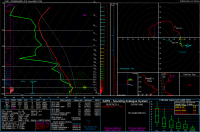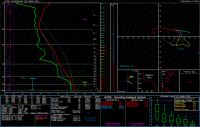Royce Sheibal
EF3
Another day 2 ENH with mention of tornadoes! Another possible bust!
If we go back to the forecast for 6-20-15, it's pretty similar. Tons of cape, good shear, warm front pushing up from the south ahead of a low in KS. I Went to Beatrice on 6-20, sat and watched the storms to the south eat up all the WAA and undercut any towers that tried to form. There was also little to no theta-E advection that day, as the winds were blowing from the NE ahead of the warm front, and along it they were pulling in cool air from the cells to the SE. It was hot, sticky, and the Cu field didn't produce until almost dark, and even then re-capped almost right away.
The difference for 6-24-15? HUGE! This time the low is forecast to actually move, instead of stalling in KS. Surface low should be just west of Omaha by 21z Wed, and moving. So now we've got much better trigger for convection, a better warm front (on 6-20 the temps were actually warmer to the north in places), a possible triple point scenario back in NE, and what looks to be lots of theta-E advection.
Two main targets for the day: N MO and all of IA vs E Neb on the triple point. SPC has mostly IA covered for the ENH, but I've got a feeling the low isn't gonna move quite that fast, and E Neb still is a good play.
NAM, NAM 4k, and even GFS pull 4k-5k cape across both targets, with a window for cap to break around 21z, and IA staying open as late as 03z. Shear is forecast to be bonkers long the warm front, as well as near the triple point in E Neb. Surface temps with some silly Td's should be in the 85-90 range and 70-75 range.
Regarding the IA side, some models are saying you should head toward SC IA and N MO, whilst other say stay further toward Des Moines or just west of DM. You also may have ongoing convection to deal with as a complicating factor. Bonus, small Vort-Max possible during the afternoon.
Regarding the Neb side, I'm worried about the dry slot, and the cap. All the models are poking a solid dry slot in pretty quickly, which could mean that only a sliver of the triple point will be viable, likely near Norfolk or Tekamah. As for the cap, just like on 6-20 it's going to be a gamble. Such is summer chases. This time around, however, we've got some major moisture convergence forecast, so things are looking better.
Good luck Chasing! I'll be at work / school Wednesday so the only way catch a TOR is if they come and visit me in Omaha!
If we go back to the forecast for 6-20-15, it's pretty similar. Tons of cape, good shear, warm front pushing up from the south ahead of a low in KS. I Went to Beatrice on 6-20, sat and watched the storms to the south eat up all the WAA and undercut any towers that tried to form. There was also little to no theta-E advection that day, as the winds were blowing from the NE ahead of the warm front, and along it they were pulling in cool air from the cells to the SE. It was hot, sticky, and the Cu field didn't produce until almost dark, and even then re-capped almost right away.
The difference for 6-24-15? HUGE! This time the low is forecast to actually move, instead of stalling in KS. Surface low should be just west of Omaha by 21z Wed, and moving. So now we've got much better trigger for convection, a better warm front (on 6-20 the temps were actually warmer to the north in places), a possible triple point scenario back in NE, and what looks to be lots of theta-E advection.
Two main targets for the day: N MO and all of IA vs E Neb on the triple point. SPC has mostly IA covered for the ENH, but I've got a feeling the low isn't gonna move quite that fast, and E Neb still is a good play.
NAM, NAM 4k, and even GFS pull 4k-5k cape across both targets, with a window for cap to break around 21z, and IA staying open as late as 03z. Shear is forecast to be bonkers long the warm front, as well as near the triple point in E Neb. Surface temps with some silly Td's should be in the 85-90 range and 70-75 range.
Regarding the IA side, some models are saying you should head toward SC IA and N MO, whilst other say stay further toward Des Moines or just west of DM. You also may have ongoing convection to deal with as a complicating factor. Bonus, small Vort-Max possible during the afternoon.
Regarding the Neb side, I'm worried about the dry slot, and the cap. All the models are poking a solid dry slot in pretty quickly, which could mean that only a sliver of the triple point will be viable, likely near Norfolk or Tekamah. As for the cap, just like on 6-20 it's going to be a gamble. Such is summer chases. This time around, however, we've got some major moisture convergence forecast, so things are looking better.
Good luck Chasing! I'll be at work / school Wednesday so the only way catch a TOR is if they come and visit me in Omaha!



